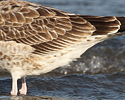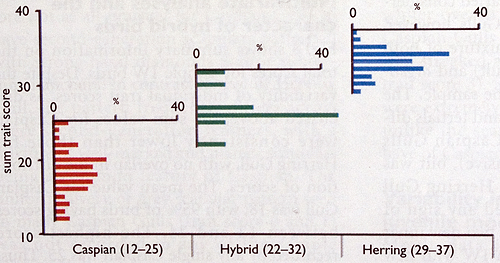 Larus cachinnans
Larus cachinnans
(last update:
Greg Neubauer
Marcin Przymencki
Albert de Jong
Mars Muusse
 sub-adult cachinnans: June
sub-adult cachinnans: June
In 2011, Chris Gibbins, Grzegorz Neubauer and Brian Small published two extensive papers in Britsih Birds, dealing with Caspian Gull. Below, you will find the content of the second paper "phenotypic variability and the field characteristics of hybrids".
The full title reads: From the Rarities Committee's files - Identification of Caspian Gull. Part 2: phenotypic variability and the field characteristics of hybrids, by Chris Gibbins, Grzegorz Neubauer and Brian Small, IN: BB 104/2011. ORDER PAPER COPY!
"we" in the text below refers to the original authors. If any errors occur in this text, please let me know and mail to marsmuusseatgmaildotcom.
PART 1: ABSTRACT & INTRODUCTION
PART 2: APPROACH
PART 3: ADULT BIRDS AND FIRST WINTER BIRDS
PART 4: DATA ANALYSIS
PART 5: VARIABILITY IN PLUMAGE (OF ADULTS)
BELOW: PART 6 OF THE PAPER
Identification of Caspian Gull. Part 2: phenotypic variability and the field characteristics of hybrids
| Primary projection | score | Herring | Caspian | Hybrid | |
| 0 | very long (ratio >0.6) | 6 | 72 | 56 | |
| 1 | moderately long (ratio 0.5-0.59) | 38 | 25 | 33 | |
| 2 | medium (ratio 0.4-0.49) | 45 | 3 | 11 | |
| 3 | short (ratio <0.4) | 11 | 0 | 0 |
Identification of first-winter birds
Table 4 presents the frequency of (different trait scores for birds in first-winter plumage (in October to March inclusive; see above). These frequency statistics form the basis of the following text.
Variability in structure
Primary projection proved to be a very useful means of distinguishing between the species. Caspian Gulls typically had a long projection of the primaries beyond the tail, with the majority of birds (72%) having a ratio >0.6 (trait score 0). The majority of Herring Gulls had either a medium (score 2) or a moderately long (score 1) projection (45% and 38% of birds respectively). However, some extremely long-winged Herring Gulls occurred in the sample, with 6% of birds having a projection of >0.6, while some Caspian Gulls (3%) had only a medium primary projection, so there is a degree of overlap. Nonetheless, it is clear that a bird with a short primary projection (ratio <0.4) is extremely unlikely to be Caspian.
Contrary to much of the published literature, the presence of a ventral bulge did not prove (quantitatively) useful for distinguishing between the species. It was not uncommon for Caspian Gulls to lack a ventral bulge (38%), while some Herring Gulls (at least in some stances) appeared to show one (14%). The statistics indicate that it would be misleading to refer to a Herring Gull with a ventral bulge or to a Caspian Gull without one as extreme or unusual.
Variability in plumage
While the Herring Gulls in the sample had a rather consistent pattern on the greater coverts (all birds were either trait score 2 or trait score 3), Caspian Gulls varied considerably. The most frequent plumage (63%) was the textbook pattern of trait score 1: a pale bar formed by the contrast between the generally dark basal and pale distal portions of each feather (plate here & here). Another frequent pattern in the greater coverts of Caspian Gulls (30% of sample birds) was a delicate “piano key” pattern or vermiculation along the whole feather edge, with the remainder of the feather being dark (trait score 2). However, 4% of the sample birds had a pattern which was much more typical of Herring and Yellow-legged Gulls L. michahellis (trait score 3), with bold notching along the feather (see plate 417). At the other extreme, some Caspian Gulls (3%) had simple pale fringes around each feather, lacking any notching (trait score 0). None of the sample Herring Gulls showed this pattern, although we have seen it on Herring Gulls in the field on rare occasions.
| Scores for greater covert (GC) patterns in 1W cachinnans. | |||
 |
 |
 |
 |
| cachinnans score 0 | cachinnans score 1 | cachinnans score 2 | argenteus score 3 |
| Greater- covert pattern |
score | Herring | Caspian | Hybrid | |
| 0 | simple pattern with brown centres and sharp white edges, with no white vermiculation or notching | 0 | 3 | 0 | |
| 1 | white edges with delicate notches or vermiculation; or dark brown centre with white tip to 1/3 of length (i.e. white restricted to tip or distal third) | 0 | 63 | 12 | |
| 2 | clear white notches / barring creating a delicate 'piano key' pattern along the whole edge / feather; but much of feather dark | 6 | 30 | 38 | |
| 3 | lots of white (more than 1/2 of coverts looking white) distributed along the whole feather, or a bold notching ('piano key' pattern) | 94 | 4 | 50 |
The tertial patterns on the sample Herring and Caspian Gulls differed markedly. Trait score 3 was typical of Herring (63%), and score 0 typical of Caspian (65%); thus, typically, the species were very different. Nonetheless, variability meant that a significant proportion of the sample Caspian Gulls (32%) had a pattern more like that of Yellow-legged Gull (trait score 1) and some had tertials which were moderately (2%) or strongly (1%) notched (scores 2 and 3 respectively), patterns typical of Herring Gull. Conversely, some Herring Gulls (c. 1%) had the diffuse pale tip that is typical of Caspian.
| Scores for 1st gen tertial patterns in 1W cachinnans. | |||
 |
 |
 |
 |
| cachinnans score 0 | cachinnans score 1 | argentatus score 2 | argenteus score 3 |
| First-generation tertial pattern | score | Herring | Caspian | Hybrid | |
| 0 | diffuse white tip (like Common Gull Larus canus) | 1 | 65 | 33 | |
| 1 | fine pale fringe around distal portion (like classic michahellis), possibly also with some vermiculations | 3 | 32 | 12 | |
| 2 | edges moderately notched | 33 | 2 | 22 | |
| 3 | edges strongly notched and/or some dark barring or pale patches across the feather on some or all tertials | 63 | 1 | 33 |
The pattern on the second-generation scapulars differed overall between the species. A significant proportion of the Caspian Gulls had trait score 0, 1 or 2 for their scapulars (68% of the sample), patterns characterized by simply marked feathers lacking strong diamonds or anchors, with numerous wholly grey feathers present. The textbook Caspian Gull pattern (e.g. plates 418 & 419) was different from that seen in the majority of Herring Gulls, in which trait score 4 was predominant (95% of birds). However, an important point is that a significant proportion of 1W Caspian Gulls had strongly patterned second-generation scapulars (32% of the sample had a pattern scored as 3 or 4).
Contrary to common perception, it is therefore not at all unusual for Caspian Gulls to have second-generation scapulars patterned with strong basal diamonds and/or subterminal anchors. In contrast to that of Herring Gull, the pattern frequently differs across these second-generation feathers, with a mixture of well-marked and plainer scapulars being a common feature of Caspian. The uniform silvery or grey scapular pattern seen in many Caspian Gulls (trait score 0 and 1) was not recorded in any of the sample Herring Gulls.
Our sample showed that it is not uncommon for Caspian Gulls to appear rather heavily streaked on the head and body in 1W plumage. While most birds were much whiter overall than Herring Gulls (84% of Caspian Gulls scored 1 or 2), 16% were as well streaked as a typical Herring Gull (i.e. trait score 3). Some (e.g. PUSZ) were extremely heavily streaked and so quite unlike the search image that most birders have of Caspian Gull.

Fig. 8. Sum trait scores for first-winter Caspian Larus cachinnans and Herring Gulls L. argentatus, and hybrids. Scores are calculated by summing individual trait score values. The figure shows the percentage of individuals in the sample with a given sum value. Numbers in parentheses are the minimum and maximum values recorded.

Fig. 9. PCA biplot showing sample first-winter Herring Larus argentatus and Caspian Gulls L. cachinnans and a number of proven and suspected hybrids. Each circle represents a sample bird. Together, axes l and 2 capture 73.4% of the variance in the sample data. The polygon to the right groups sample Caspian Gulls, while that to the left groups Herring Gulls. Hybrid birds are highlighted in red; numbers relate to plates that show examples of some of these hybrids. Codes for traits are: Bill=bill length:depth ratio, Pproj=length of primary projection, TM=extent of tertial moult, GCovM=extent of greater-covert moult, MCovM=extent of median-covert moult, ScapM=extent of scapular moult, GCovPat=greater-covert pattern, Tpat=tertial pattern, Legs=leg length,Vbul=presence of ventral bulge, Darkness=extent of streaking on head and body, and ScapP is the pattern on second-generation scapulars.
END OF PART 6
CONTINUE PART 7: Variability in extent of the post-juvenile moult
 Larus cachinnans 2CY-5CY UKK T-001874 May 2010 - July 2013, Windheim & Deponie Pohlsche Heide - Minden, Germany.
Picture: Armin Deutsch.
Larus cachinnans 2CY-5CY UKK T-001874 May 2010 - July 2013, Windheim & Deponie Pohlsche Heide - Minden, Germany.
Picture: Armin Deutsch.  barabensis type sub-adult, June 02 2007, Sverdlovsk oblast - SE Urals. Picture: Annika Forsten & Antero Lindholm.
barabensis type sub-adult, June 02 2007, Sverdlovsk oblast - SE Urals. Picture: Annika Forsten & Antero Lindholm. barabensis type sub-adult, June 05 2007, Sverdlovsk oblast - SE Urals. Picture: Annika Forsten & Antero Lindholm.
barabensis type sub-adult, June 05 2007, Sverdlovsk oblast - SE Urals. Picture: Annika Forsten & Antero Lindholm.










